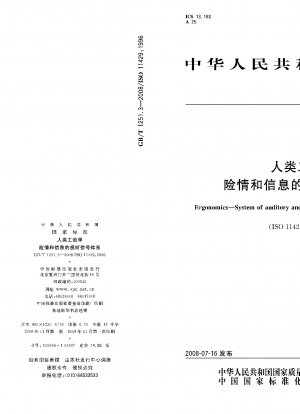GB/T 1251.3-2008
Ergonomics.System of auditory and visual danger and information signals (English Version)
- Standard No.
- GB/T 1251.3-2008
- Language
- Chinese, Available in English version
- Release Date
- 2008
- Published By
- General Administration of Quality Supervision, Inspection and Quarantine of the People‘s Republic of China
- Latest
- GB/T 1251.3-2008
- Replace
- GB 1251.3-1996
- Scope
- In order to reduce the risk of misinterpreting visual and auditory distress signals, this part of GB/T 1251 specifies a system of distress and information signals with different levels of urgency. This part is applicable to all kinds of dangerous signals and information signals, including signals that need to be clearly detected and distinguished in accordance with 5.3 of GB/T 15706.2-2007, and signals that need to be clearly detected and distinguished under other requirements or working conditions; this part Also applies to all signals with an urgency ranging from "Extreme Urgent" to "All Clear". When an audio signal is supplemented by a visual signal, the signal characteristics of both shall be specified. This section does not apply to areas where specific standards or other mandatory practices (international or national) have been adopted, especially fire alarms, medical alarms, alarms used in public transport, navigation signals and for special field activities (for example, military activity). However, for consistency, this section should be referred to when adopting new signals. For auditory information signals classified according to urgency, the signal characteristic system specified in this part can be used as a guide for the design of the signal language. In order to identify the signal reliably and quickly, this standard specifies the specific characteristics of the signal. Certain classes of signals allow changes in signal characteristics, such as control and warning signals for employees with specific training in the workplace. For visual signals, the meaning of existing safety colors is not affected by this standard. According to different needs, timing patterns and color alternation can be used as supplementary meanings of visual signals. Color alternation is used only in rare cases.
GB/T 1251.3-2008 Referenced Document
- GB 1251.1-1989 Danger signals for work places--Auditory danger signals
- GB/T 1251.2-2006 Ergonomics Visual danger signals general requirements design and testing
- GB/T 12800 Acoustics--Audible emergency evacuation signal
- GB/T 13379 Visual Ergonomic Principles for Indoor Workplace Lighting*, 2023-09-07 Update
- GB/T 15706.2-1995 Safety of machinery--Basic concept, general principles for design. Part 2: Technical principles and specifications
- ISO 9921-1:1996 Ergonomic assessment of speech communication - Part 1: Speech interference level and communication distances for persons with normal hearing capacity in direct communication (SIL method)
GB/T 1251.3-2008 history
- 2008 GB/T 1251.3-2008 Ergonomics.System of auditory and visual danger and information signals
- 1996 GB/T 1251.3-1996 Ergonomics—System of danger and non-danger signals with sound and light
GB/T 1251.3-2008 Ergonomics.System of auditory and visual danger and information signals has been changed from GB 1251.3-1996 Ergonomics--System of danger and non-danger signals with sound and light.
